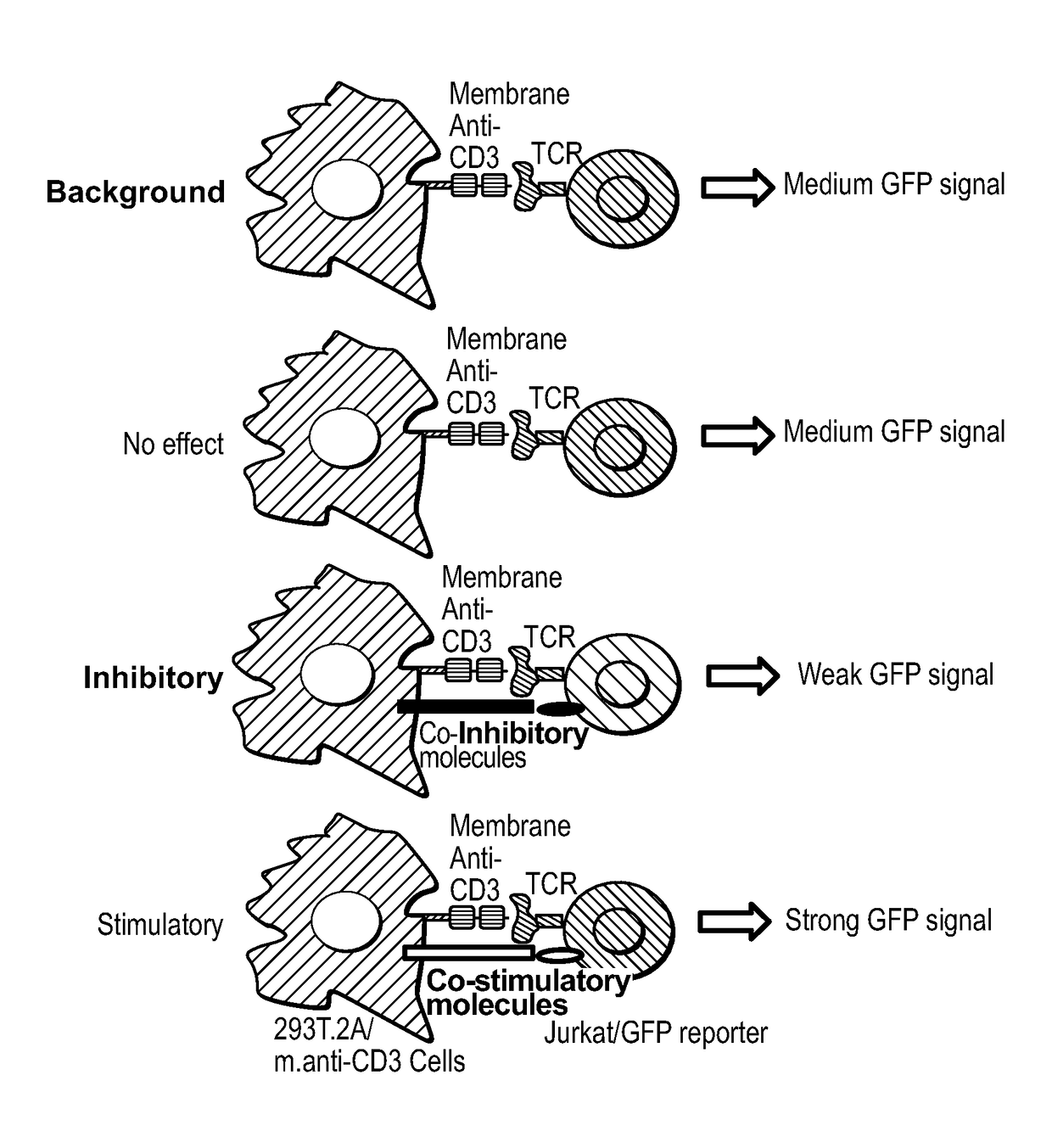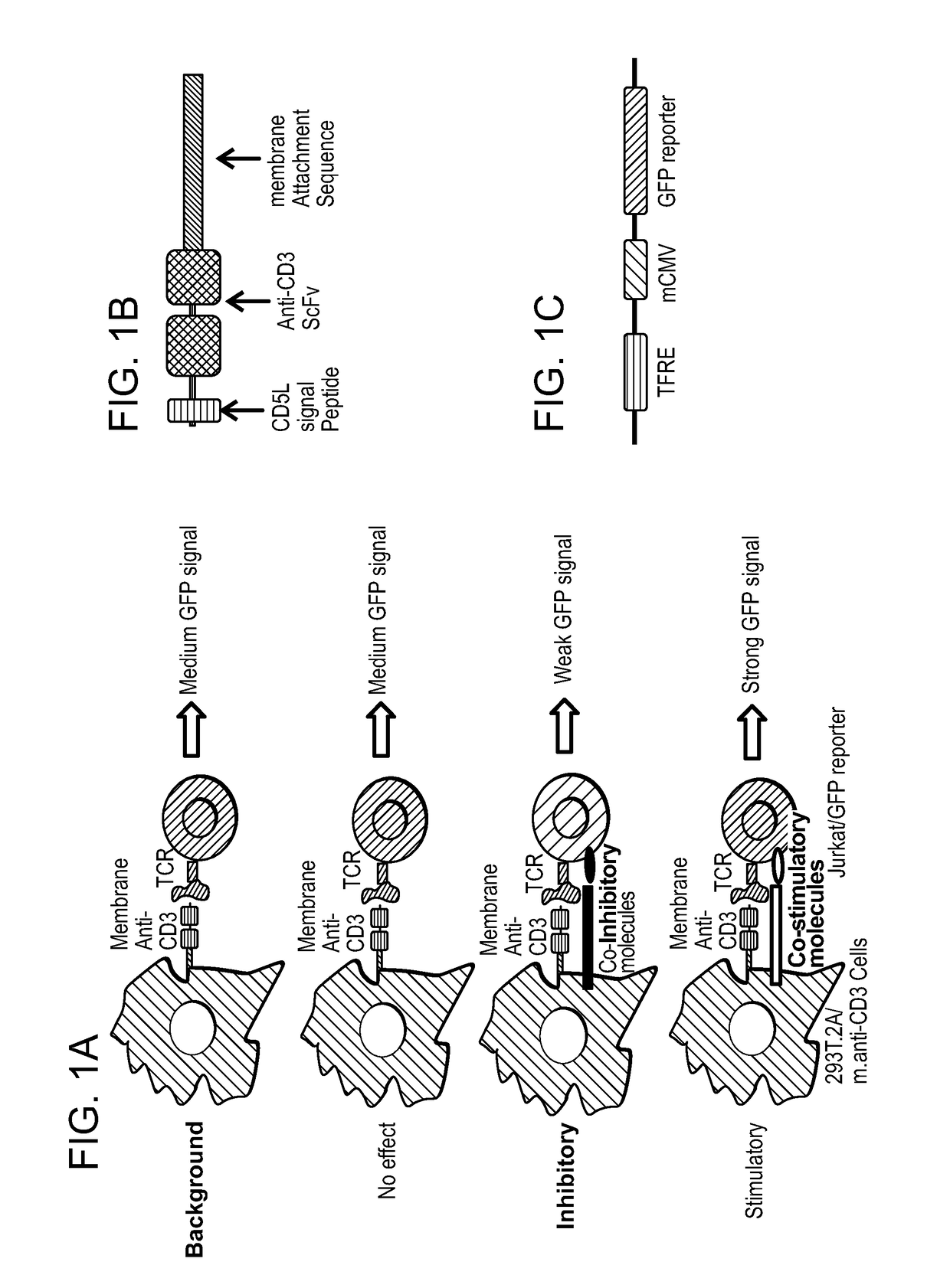Genome-scale t cell activity array and methods of use thereof
a technology of t cell activity and genome level, which is applied in the field of genomic t cell activity array, can solve the problems of not being able to establish a well-established system for assaying t cell activity at the genome level, and a large portion of cancer patients do not respond to anti-pd-1 therapy, etc., and achieve the effect of assisting in identification
- Summary
- Abstract
- Description
- Claims
- Application Information
AI Technical Summary
Benefits of technology
Problems solved by technology
Method used
Image
Examples
example 1
Construction of the Genome-Scale T Cell Activity Array (GS-TCAA)
[0121]In order to conduct human genome-wide searches of targets for future immunotherapies, a genome-scale T cell activity array was developed. 6402 human membrane cDNA, covering 90% of the human membrane genome, were prepared using Qiagen miniprep kits, quantified and diluted for GS-TCAA construction.
[0122]Optimal T cell activation requires both antigen-specific primary signals through the TCR / CD3 complex, and co-signaling involved in secondary signaling. To set up functional T cell assays, a 293T cell based artificial antigen presenting cell line that stimulates basal T cell activation was designed, and fluoresent reporters were used as indicators of T cell activities (FIG. 1A). Specifically, the 293T.2A cells were used for the activity array. These 293T.2A cells were engineered 293T cells that express major immune-related adaptors (DAP10 / DAP12 / FcRγ / CD3E) for optimal expression of immune-related membrane genes. In add...
example 2
Detection and Screening of the Genome-Scale T Cell Activity Array
[0125]In order to optimize the screening system for the T cell activity array, the transfection efficiency of the 293T / m.anti-CD3 cells in 1536-well plates was tested and the optimal conditions required for T cell activities in these two cell co-culture systems were determined. In addition, GFP detection using an InCell Imaging system was also optimized for the activity array.
[0126]Gene clones were transferred into Greiner 1536-well imaging plates using an optimized protocol for the automatic plate handling system (Matrix PlateMate Plus, Thermo Scientific). Each GS-TCAA set contains four 1536-well imaging plates. For the array screening, an optimized reverse transfection protocol was utilized, such that these genes were individually displayed on the cell surface of 293T.2A / m.anti-CD3 cells. The cDNA library plasmids were mini-preped individually and then diluted in OptiMEM (4 μg / ml) and transferred into 384-deep-well p...
example 3
Validation of Novel Immune Regulatory Genes with the Potential to Treat Cancer / Autoimmune Disease
[0130]To further validate the function of gene candidates obtained from the GS-TCAA studies, in vitro functional assays with primary human T cells are performed. In addition, bioinformatics approaches are utilized to narrow down genes associated with autoimmune diseases and / or cancers. Several top gene candidates are also screened for potential counter-receptor identification in a receptor array system and are selected for in vivo studies to test the therapeutic potential of cancer / autoimmune disease in humanized mouse disease models, including the humanized mouse PDX models.
In Vitro T Cell Functional Assay
[0131]Top gene candidates identified from the GS-TCAA analysis are validated by in vitro functional assays using primary T cells. 293T.2A / m.anti-CD3 cells are transfected with gene candidates and co-cultured with human primary CD8 or CD4 cells. Assays for T cell proliferation, apoptosi...
PUM
 Login to View More
Login to View More Abstract
Description
Claims
Application Information
 Login to View More
Login to View More - R&D
- Intellectual Property
- Life Sciences
- Materials
- Tech Scout
- Unparalleled Data Quality
- Higher Quality Content
- 60% Fewer Hallucinations
Browse by: Latest US Patents, China's latest patents, Technical Efficacy Thesaurus, Application Domain, Technology Topic, Popular Technical Reports.
© 2025 PatSnap. All rights reserved.Legal|Privacy policy|Modern Slavery Act Transparency Statement|Sitemap|About US| Contact US: help@patsnap.com



